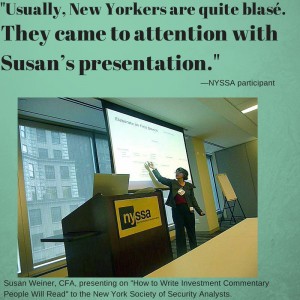Tweet your quarterly investment commentary for more impact
“Second Quarter Market Update”—I can’t tell you how many times I’ve seen this boring status update in my Twitter streams, LinkedIn, or Facebook. You can attract more views, and get more people to click your links when you strengthen the status updates you share via social media. I have some tips for you.
1. Highlight your opinions, not the date
Everybody knows what quarter has just ended, but they don’t know your opinions about what drove the period’s returns or how you view the stock and bond markets’ future. This is why you should highlight your opinions with subject lines such as “3 reasons why stocks will continue to rise [LINK TO YOUR COMMENTARY].”
By the way, use a link shortener, such as bitly or the link shorteners in HootSuite, to make the best use of the limited character count available to you in status updates, especially Twitter.
2. Pose questions
People are curious. Take advantage of that by asking questions in your status updates. For example, “Which sectors are positioned to outperform for 2014? Read our views: [LINK TO YOUR COMMENTARY].”
3. Use images
Images increasingly drive social media engagement, even on Twitter. A powerful image will boost views and clicks. This may mean including two links in your tweets—one to the image and another to your commentary.
By the way, your logo or headshot photo doesn’t count as a compelling image. A graph or photo could work.
4. Link directly to your commentary
Many investment management firms force their social media readers to click twice to reach their commentary, which lives on their websites as prettily formatted PDF documents. However, every time you ask readers to click, you risk losing them.
To avoid this risk, put your commentary—or at least a big chunk of the opening text on an ordinary web page.
5. Tweet more than once
Don’t expect one tweet to reach all of your target readers. Share your quarterly commentary more than once. Mix up your status updates, perhaps highlighting a key finding in one, but asking a question in another.
Your tips?
I’m curious to learn what works for you in getting readers from your social media status updates. Please join the conversation.
Image courtesy of artur84 / FreeDigitalPhotos.net
Note: updated November 10, 2020





 For example, I created a text block to accompany my virtual book tour’s links, as in “
For example, I created a text block to accompany my virtual book tour’s links, as in “


